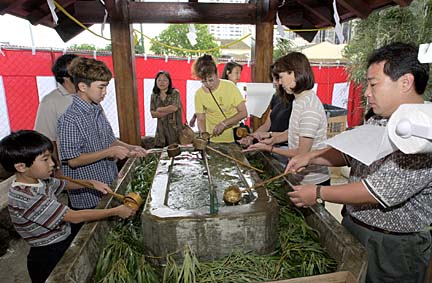Advertisement - Click to support our sponsors.


‘Hatsumoude’ "Hatsumoude," the traditional New Year's Day cleansing visit to shrines by Shinto Buddhists, attracted thousands of people to Izumo Taishakyo Mission of Hawaii near Aala Park.
offers New Year's
cleansing
Thousands take part in the
Shinto Buddhist tradition to
'wipe the slate clean with a
renewed promise of hope
and well-being'By Rod Ohira
Star-BulletinToshihisa and Sanae Tamai and their daughter, Serena, were among the arrivals right around sunset. The Tamais said they do not attend services regularly but have been coming to the 78-year-old shrine on New Year's Day for the past 10 years.
"We come here for good luck," Mr. Tamai said.
They also come to purchase an "omamori," a brocade covered amulet, for their daughter, who is a freshman at the University of Hawaii.
"It's so I do well at UH and have a safe year," Serena Tamai said.
Richard T. Miyao, executive director of the mission's board of directors, estimated that 10,000 people visited the downtown shrine yesterday.

The religious and spiritual significance of the "hatsumoude" visit for 90 percent of the visitors is to "wipe the slate clean with a renewed promise of hope and well-being at the start of the year," Miyao said."It's a cultural thing," he added. "The one thing we don't have is a golfer's amulet for a hole in one."
The visit to the shrine consists of many symbolic steps that start with passing under the "torii," or gate, followed by the washing of hands with clear running water at a basin.
The washing represents a spiritual cleansing.
The decorations of pine and bamboo symbolize resilience and freshness of the new year.
There's a straw rope attached to a bell called a "shimenawa" and a collection box near the steps that lead inside the shrine. Visitors drop money, usually coins, into the wooden box before pulling the rope.
The bell is rung to call the "kami" or gods for prayer.

Before entering the shrine for prayer, visitors clap their hands at least two times -- at Izumo, it's four times -- and while their heads are bowed, a priest waves a wooden wand, or "gohei," with white paper streamers over their heads.Waving the wand represents purification and blessing.
After the blessing, visitors are offered a communion of rice wine at a booth.
At the same time, they can purchase an "ofuda," which is a talisman for protection of house and business, and various "omamori" for protection in traffic or special occasions, such as pregnancies.
During the same visit, they bring their old "ofuda" to be burned at the shrine.
"It is a time to pray for good luck and health in the new year," said Yoshie Kobayashi, studying for her doctorate at UH.
The Rev. Daiya Amano of Izumo Taishakyo Mission in Hawaii said there are three other similar shrines on Oahu -- in Nuuanu, Kapalama and McCully -- open on New Year's Day.
Hawaii Izumo Taisha, a Shinto sect affiliated with Taisha Oyashiro Kyo of Taisha Machi, Shimane-Ken, Japan, has been serving New Year's Day visitors here since 1906.